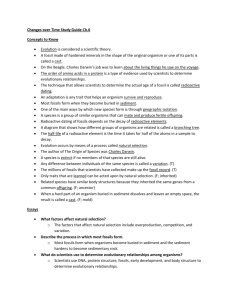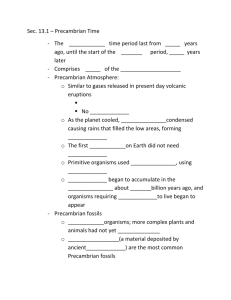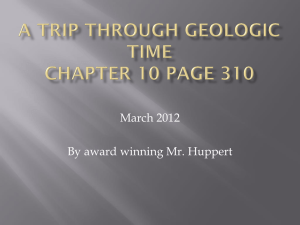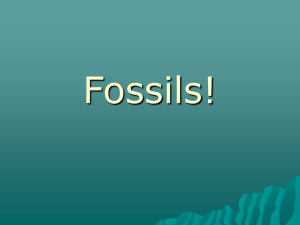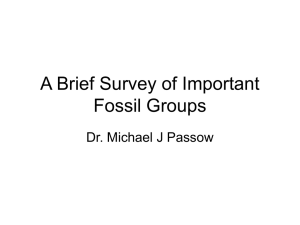Chapter 17 History of Life PTHS 2014
advertisement
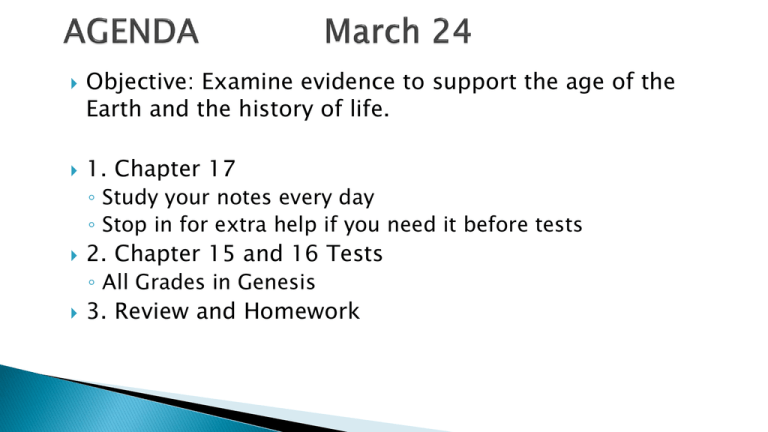
Objective: Examine evidence to support the age of the Earth and the history of life. 1. Chapter 17 ◦ Study your notes every day ◦ Stop in for extra help if you need it before tests 2. Chapter 15 and 16 Tests ◦ All Grades in Genesis 3. Review and Homework Chapter 17 Paleontologists study fossils. Fossil Record provides evidence of the history life on Earth. ◦ Infer structure of organisms ◦ What they ate ◦ Environments they lived in Fossils appear in a particular order. ◦ Some only present in older rocks ◦ Some only in newer rocks Recall that fossils form in sedimentary rock. Weather breaks down rock into small particles. ◦ Particles carried by water where they settle to the bottom. ◦ Pressure and chemical processes preserve remains into rock. Why is the fossil record an incomplete record of life on Earth? Identify and compare anatomical structures between fossils and living organisms. Age of a fossil is determine by two techniques. 1. Relative Dating 2. Radioactive Dating Determines age of fossil by comparing its placement with other fossils in various layers of rock. ◦ Oldest layers on bottom Index fossils are easily recognizable for comparison. ◦ Existed for a short period of time ◦ Wide geographic range ◦ Found in specific layers of rock in different locations. Use of radioactive decay to assign ages to fossils. ◦ Some elements are radioactive ◦ Decay is measured as HALF-LIFE or the time for half of the radioactive atoms in a sample to decay Age of a fossil based upon amount of remaining radioactive isotope it contains. Different radioactive elements have different half-lives. Carbon 12 most common and does not decay Carbon 14 radioactive and decays into N-14 ◦ Has half-life of 5730 Years ◦ More C-12 compared to C-14 = older fossil Which of the following cannot be determined through fossils? A. the approximate age of the organism B. other organisms closely related to the fossilized organism C. anatomical structure of an organism D. physiological processes of the organism Objectives: Investigate factors that led to the formation of Earth and early forms of life. 1. 2. 3. 4. 5. Question of the Day Continue Chapter 17 Notes Complete the Guided Reading Packet Chapter 16 Tests Review and Homework Represents evolutionary time. Precambrian Time Eras Periods Cenozoic – Age of Mammals 65 mya to present Precambrian Time Paleozoic, Mesozoic, and Cenozoic Eras Eras are further subdivided into Periods Periods range from 10s of millions of years to 2 million years Birth of planet took place over 100 million years Collisions with other large objects ◦ Produced tremendous amount of heat Most dense elements formed Earth’s core ◦ Decay created a molten rock core Moderately dense elements cooled into Earth’s crust. Least dense formed first atmosphere NOTES are in the Guided Reading Packet. Answer Key is posted on my webpage. Miller and Urey’s Experiment – 1950s Atoms do not assemble themselves into complex molecules or living cells today. ◦ Oxygen is very reactive See FIGURE 17-8 PAGE 424 Suggested how mixtures of organic compounds necessary for life could have been formed from simpler compounds Radioactive Uranium-232 has a half-life of approximately 70 years. The Chernobyl Nuclear Power Plant Disaster in 1986 released high levels of radiation into nearby surrounding areas including the town of Pripyat. What year would see a reduction in radiation to 20% of the original level of uranium-232? Briefly describe how Miller and Urey simulated Earth’s early atmosphere. Mixed hydrogen, methane, and ammonia with water vapor. Charged the mixture with electric sparks. Cooled the mixture of gases. Found the formation of amino acids and other organic compounds. Objectives: Investigate factors that led to the formation of Earth and early forms of life. 1. Question of the Day 2. Complete the Guided Reading Packet 3. Discuss 17-2 Guided Reading Questions ◦ Packet DUE TOMORROW – THURSDAY March 27 ◦ Answer Key will be posted on my webpage ◦ Any late work will receive a 50% penalty. 4. Review and Homework What event was necessary for the first cells to appear on the planet? What types of organisms did these first cells resemble? Which of the following statements is true? A. Anaerobic organisms require oxygen to survive. B. Aerobic organisms can survive in environments with or without oxygen. C. Aerobic organisms do not require oxygen for cellular processes. D. Anaerobic organisms will die in an oxygen-rich environment. What are the three pieces of evidence that support the Endosymbiotic Theory? 1. Mitos and Chloros contain DNA similar to bacterial DNA. 2. Have ribosomes whose size and structure closely resemble those found in bacteria. 3. Reproduce by binary fission like bacteria. How do cells reproduce? Objectives: Investigate factors that led to the formation of Earth and early forms of life. 1. Question of the Day and DO NOW 2. 17-2 Homework Check 3. 17-3 Evolution of Multicellular Life ◦ Answer Key will be posted on my webpage TOMORROW ◦ Any late work will receive a 50% penalty. 4. Review and Homework http://www.bing.com/videos/search?q=Miller+and+Urey+Ex periment+Animation&Form=VQFRVP#view=detail&mid=CDF2 71175991A1838660CDF271175991A1838660 Precambrian Time- 90% of Earth’s history ◦ Life only existed in the seas ◦ Simple anaerobic life photosynthetic forms aerobic life ◦ Eukaryotes Multicellular organisms ◦ Why do very few fossils exist from this time? Cambrian Period – Cambrian Explosion ◦ Invertebrates, brachiopods, arthropods (trilobites) Devonian Period – Plants adapt to drier areas ◦ Insects ◦ Age of Fishes – jaws, bony skeletons, scaled bodies SHARKS!!! First land animals – amphibians Carboniferous Period – reptiles and giant insects plant remains coal Mass Extinction – 95% of life extinct Dominance of dinosaurs and flowering plants Triassic Period – Age of Reptiles ◦ 225 mya first dinosaurs ◦ First mammals very small Jurassic Period – Dinosaurs ruled Earth ◦ Archaeopteryx appeared – first birds ◦ Fossils show skulls/teeth of dinos but body and feathers of birds Cretaceous Period – T. rex and flying reptiles ◦ Flowering plants produced seeds enclosed in fruit ◦ EXTINCTION EVENT Age of Mammals Mammals evolve to live in different environments Tertiary Period – Earth warm and mild ◦ Whales and dolphins evolve ◦ Grasses provide food source for grazing mammals Quaternary Period – Ice Ages Ocean levels drop 100 meters 20,000 years ago – climate warms Mammals such as bats, cattle, mammoths common 200,000 years ago – first fossils of Homo sapiens in Africa What is macroevolution? 1. Extinction Most researchers look for a single massive event – Asteroid striking Earth at Chicxulub Crater, Mexico ◦ Extinction of dinosaurs Ecosystems collapse due to natural factors (earthquakes, volcanoes) ◦ Organisms still able to compete ◦ Food webs destroyed Disrupts energy flow adaptive radiation: multiple species evolve from a single species ◦ also known as divergent evolution ◦ Darwin’s Finches convergent evolution: different species evolve to have similar appearances and behaviors ◦ ◦ ◦ ◦ Different groups of mammals or dinosaurs Different locations Different times Similar environments Process in which two species evolve in response to changes in each other over time ◦ An evolutionary change in one organism ◦ A corresponding change in another organism ◦ Plant defense vs. fedding insect punctuated equilibrium: involves long periods of stability that are interrupted by episodes of rapid change gradualism: evolution occurs slow and steady over a long period of time Recall the function of HOX Genes. Changes in genes can produce changes in growth and differentiation during embryonic stages of life. ◦ Turning genes OFF ◦ Changing timing of cell differentiation and gene expression ◦ Long vs short legs ◦ Single winged vs double winged punctuated equilibrium: involves long periods of stability that are interrupted by episodes of rapid change gradualism: evolution occurs slow and steady over a long period of time

